
Amazon Vendor Central vs Seller Central
Over 5 million sellers are involved in selling on Amazon. Amazon is a third-party marketplace where services are offered by the third-party sellers and contribute $80 and reports that online sales will reach $5 billion in 2030. Worldwide sellers registered on Amazon increased to 200,000 in the year 2020 from 2019, which signified 45% growth. Thus, sellers either go for an Amazon Seller Central account or Vendor Central, both have their benefits and losses. Let’s move onto Amazon Vendor Central vs Seller Central topic deeply.
What is Seller Central?
Amazon Seller Central is your one-stop destination for managing and maintaining your product listings, increasing your knowledge with the materials and resources you need for success as an Amazon seller. Amazon Seller Central streamlines the process of selling on Amazon and assists in removing difficulties by creating an all-in-one hub providing all the knowledge and tools you need.
Eligibility Criteria for Creating an Amazon Seller Central Account
For creating an Amazon Seller Central account, you’ll require a GST to register as a seller. You should also have business Gmail and a phone nearby for account verification.
Access the Seller Central Dashboard –
1. Start Amazon Seller Registration
2. Set up payment information (credit card or bank account)
- Provide further information about your business, including Business Type (Individual or professional)
- Product categories you further want to sell in.
- Return policy and customer service information.
- Review and accept all terms and conditions.
- Verify your identity, with a government ID.
3. Set up the store information, including:
Store name and description.
For instance, setting up a store would require a name, make sure it’s catchy and memorable for you, and something reflective of your brand. Afterwards, write a compelling description.
4. Design your Logo and branding.
For this option, design a versatile, simple logo for your brand. Make sure to develop a consistent visual style, including colours that align and go well with the store’s personality.
Complete the registration process and wait for the review of the Amazon team for your account approval.
Costs and Fees
The sellers have to pay referral fees of 8% to 15% of the sale price and FBA fees, if applicable.
Subscription fees: a professional seller account costs $39.99 per month; an individual seller account is free but charges $0.99 per item sold.
By doing so, sellers will have the ability to make use of sponsored products, sponsored brands, and sponsored display ads, which will greatly increase the visibility of products and increase sales.
Seller Performance Metrics:
The performance metrics are very important inside Seller Central. Sellers must ensure the good health of the account by handling returns and keeping satisfied customers to not incur a penalty or suspension of their accounts.
Pros and cons for Amazon Seller Account
Pros:
- Control over pricing.
- Enhanced Branding and marketing.
- Payouts every week.
- Amazon FBA
Cons.
- Responsibility for inventory management, customer services and returns.
- High competition.
- Fees add up.
- Advertising costs and Additional costs.
What is Amazon Vendor Central?
For businesses that are looking to reach the maximum number of customers, and do a lot of sales then Amazon Vendor Central has got you covered. It is an online platform that allows sellers to sell products on Amazon. It is for the people that are invited.
Access and Manage Amazon Vendor Central in 5 easy steps –
- First, go to the Account tab in Account Management.
- Next, click on Add accounts, then proceed to Amazon Vendor Central, and then click on Next.
- If you already have an existing Amazon-sponsored account, proceed to click on Yes and select the account. If not, click on no, Type your account name and click on next.
- Now, if you’re the account owner, click on Yes. If not, click on No and share the Authorization link with the account owner.
- Once the above steps are completed you’ll, as a next step, be taken to the Amazon vendor central login page. Enter your account credentials and provide consent on the next screen.
Amazon Vendor Central Cost
In Amazon Vendor Central, Amazon purchases the products from the vendor at a wholesale rate.
Vendors do not pay fees, instead, Amazon is the one to take care of the pricing, promotion, and inventory management as well.
Benefits of Amazon Vendor Central:
- The company will provide fixed methods for shipping the goods.
- When selling online, vendors have to use the same methods that were used in the past.
- It is the vendor’s responsibility as a customer to choose how much an item should cost.
Attributes of Vendor Central
The following are the core attributes of Vendor Central:
1. Wholesale Relationship:
Vendors sell goods directly to Amazon at a wholesale price. Amazon takes ownership of this inventory and takes responsibility for pricing, shipping, and customer service.
2. Purchase Orders and Payments:
Vendors are issued purchase orders outlining the quantity and price of products that Amazon would want to buy, with the products paid for based on the agreed terms, usually within 30, 60, or 90 days.
3. Marketing and Merchandising:
Vendors can use Amazon’s marketing and merchandising muscle, which is developed with enhanced brand content through A+ Content and full participation in promotional activities such as Prime Day and Black Friday.
Comparison and Key Considerations
- Control vs. Convenience:
The latter, Seller Central, allows more control over the business when it comes to things like pricing, inventory, and branding while requiring a greater effort in Amazon Seller Central Management. Vendor Central brings convenience in the fact that Amazon takes care of logistics and customer service, whereas vendors lose control over price and inventory management.
- Profit Margins:
Higher profit margins may be obtained from selling on Seller Central since the price is determined by the seller, and so are the cost controls. On the other hand, Vendor Central has lower margins that are inclusive of wholesale pricing but often does guarantee more volume sales.
- Growth and Scaling:
While Seller Central can be more scalable for businesses that invest in logistics and marketing, Vendor Central could provide fast growth through Amazon’s comprehensive reach and marketing machinery. However, they may require high initial volume and reliability to attract and retain Amazon’s interest.
- Brand Control and Customer Information:
In Seller Central, sellers have access to customer information, which is useful in marketing and customer relationship management. That type of data in Vendor Central is not as easily accessed since Amazon owns the relationship with the customers.
Pros and Cons for Vendor Seller Account
Pros:
- Bulk orders by Amazon
- Prime eligibility.
- Less responsibility.
- Marketing support.
Cons:
- Pricing control.
- Inventory control.
- Strict requirements.
- Vendor fees.
Amazon Vendor Central vs Seller Central - Differences
|
Amazon Seller Central |
Amazon Vendor Central |
|
|
1 |
Amazon Seller Central is for people who want to start their own business. |
Whereas Vendor Central is for people who are an established brand but are looking to sell products in bulk on Amazon. |
|
2 |
Amazon Seller Central is used for handling the process of selling and shipping. |
Here Amazon handles the complete process. |
|
3 |
Third-party sellers create the advertisements inside Seller Central. |
First-party sellers in the vendor central have the power to create Advertisements, sponsored Products, and Display ads. |
|
4 |
The different types of advertisements for Seller Central are Sponsored products and Headline search ads. |
The different types of advertisements for Vendor Central are: Display ads, Sponsored Products and Headline search ads. |
|
5 |
The advertisement targeting methods for Seller Central are: Keyword level. |
The advertisement targeting methods for Vendor Central are: Product-level, Keyword-level and Interest-level. |
|
6 |
The seller central decides on the profit margin. |
Amazon decides on the profit margin. |
|
7 |
Most Sellers go for Seller Central as it is easy to set up. |
The Vendor Central comes with paid and premium features. |
Conclusion - Amazon Vendor Central vs Seller Central
The choice between Amazon Vendor Central and Seller Central depends, to a great extent, on the goals, resources, and market strategy of a business. While Seller Central is ideal for those looking for control, higher margins, and direct customer relationships, Vendor Central is best for those businesses that aim to sell large volumes with minimum logistical hassles.
“Choosing the right platform can keep your brand successful on Amazon. We chose Seller Central because of the flexibility of the channel and dealing directly with customers, which was important for us to grow,” says one retailer. Understand the nature of your business needs carefully, and start with Seller Central as you begin brand building and customer acquisition before moving on to Vendor Central later when your operations get more complex.
Still confused with or want to know more about Amazon Vendor Central vs Seller Central? contact GrowithAmazon, one of the best amazon consultancy services providers in the world.





